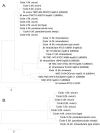Sequencing of hsp65 distinguishes among subsets of the Mycobacterium avium complex
- PMID: 16455896
- PMCID: PMC1392684
- DOI: 10.1128/JCM.44.2.433-440.2006
Sequencing of hsp65 distinguishes among subsets of the Mycobacterium avium complex
Abstract
The Mycobacterium avium complex consists of epidemiologically distinct subsets. The classification of these subsets is complicated by a number of factors, including the ambiguous results obtained with phenotypic and genetic assays and the recent appreciation that human and avian strains appear to be distinct. In previous work, sequencing based on a 441-bp portion of the hsp65 gene has proven to efficiently classify isolates within the Mycobacterium genus but provides low resolution for distinguishing among members of the M. avium complex. Therefore, in this study, we have targeted the more variable 3' region of the hsp65 gene to determine whether it can effectively discriminate M. avium complex isolates at the levels of species and subspecies. Primers designed for this target consistently generated amplicons for all organisms classified as M. avium complex. Sequences obtained indicate that M. intracellulare is genetically divergent from M. avium organisms, and distinct sequevars were obtained for M. avium subsets, including M. avium subsp. avium (bird type), M. avium subsp. hominissuis, and M. avium subsp. paratuberculosis. In addition, sequence differences served to distinguish bovine from ovine strains of M. avium subsp. paratuberculosis. A unique profile for M. avium subsp. silvaticum was not obtained. These results indicate that sequencing the 3' region of the hsp65 gene can simply and unambiguously distinguish species and subspecies of the M. avium complex.
Figures

Similar articles
-
Subspecific differentiation of Mycobacterium avium complex strains by automated sequencing of a region of the gene (hsp65) encoding a 65-kilodalton heat shock protein.Int J Syst Bacteriol. 1997 Apr;47(2):414-9. doi: 10.1099/00207713-47-2-414. Int J Syst Bacteriol. 1997. PMID: 9103630
-
Species identification of Mycobacterium avium complex isolates by a variety of molecular techniques.J Clin Microbiol. 2000 Feb;38(2):508-12. doi: 10.1128/JCM.38.2.508-512.2000. J Clin Microbiol. 2000. PMID: 10655336 Free PMC article.
-
Detection of Mycobacterium avium & M. tuberculosis from human sputum cultures by PCR-RFLP analysis of hsp65 gene & pncA PCR.Indian J Med Res. 2006 Feb;123(2):165-72. Indian J Med Res. 2006. PMID: 16575116
-
[Mycobacterium avium-intracellulare complex: phenotypic and genotypic markers and the molecular basis for interspecies transmission].Bull Soc Pathol Exot. 2000 Jul;93(3):182-92. Bull Soc Pathol Exot. 2000. PMID: 11030055 Review. French.
-
Mycobacterium avium in the postgenomic era.Clin Microbiol Rev. 2007 Apr;20(2):205-29. doi: 10.1128/CMR.00036-06. Clin Microbiol Rev. 2007. PMID: 17428883 Free PMC article. Review.
Cited by
-
Mycobacterium avium Complex Extracellular Vesicles Attenuate Inflammation via Inducing IL-10.Int J Mol Cell Med. 2018 Fall;7(4):241-250. doi: 10.22088/IJMCM.BUMS.7.4.241. Epub 2019 Apr 7. Int J Mol Cell Med. 2018. PMID: 31516884 Free PMC article.
-
Iron-sparing response of Mycobacterium avium subsp. paratuberculosis is strain dependent.BMC Microbiol. 2010 Oct 22;10:268. doi: 10.1186/1471-2180-10-268. BMC Microbiol. 2010. PMID: 20969756 Free PMC article.
-
Genetic analysis of Mycobacterium avium complex strains used for producing purified protein derivatives.Clin Vaccine Immunol. 2006 Sep;13(9):991-6. doi: 10.1128/CVI.00217-06. Clin Vaccine Immunol. 2006. PMID: 16960109 Free PMC article.
-
Sequence polymorphisms in a surface PPE protein distinguish types I, II, and III of Mycobacterium avium subsp. paratuberculosis.J Clin Microbiol. 2008 Apr;46(4):1207-12. doi: 10.1128/JCM.02031-07. Epub 2008 Feb 13. J Clin Microbiol. 2008. PMID: 18272710 Free PMC article.
-
Anti-microbial Antibodies, Host Immunity, and Autoimmune Disease.Front Med (Lausanne). 2018 May 23;5:153. doi: 10.3389/fmed.2018.00153. eCollection 2018. Front Med (Lausanne). 2018. PMID: 29876352 Free PMC article. Review.
References
-
- Baess, I. 1983. Deoxyribonucleic acid relationships between different serovars of Mycobacterium avium, Mycobacterium intracellulare and Mycobacterium scrofulaceum. Acta Pathol. Microbiol. Immunol. Scand. Sect. B Microbiol. 91:201-203. - PubMed
-
- Collins, D. M., S. Cavaignac, and G. W. de Lisle. 1997. Use of four DNA insertion sequences to characterize strains of the Mycobacterium avium complex isolated from animals. Mol. Cell. Probes 11:373-380. - PubMed
-
- Collins, D. M., D. M. Gabric, and G. W. de Lisle. 1989. Identification of a repetitive DNA sequence specific to Mycobacterium paratuberculosis. FEMS Microbiol. Lett. 51:175-178. - PubMed
Publication types
MeSH terms
Substances
Associated data
- Actions
- Actions
- Actions
- Actions
- Actions
- Actions
- Actions
- Actions
- Actions
- Actions
- Actions
- Actions
- Actions
- Actions
LinkOut - more resources
Full Text Sources
Other Literature Sources
Molecular Biology Databases
Research Materials

